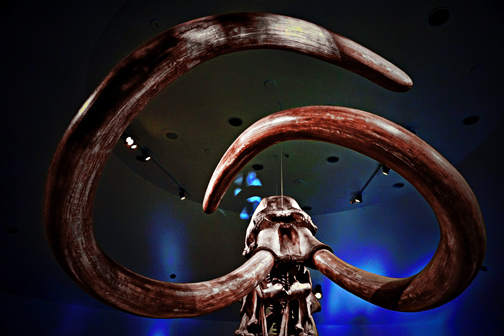
Photo by Charly SHELTON
By Charly SHELTON
Los Angeles, 30,000 years ago, was much like the Los Angeles of today – it was crowded with traffic. Well, relatively speaking.
The LA basin was a lush area of little streams and low-lying plants with clusters of shade trees, and the basin and valleys made for easy travel. This encouraged many migratory populations of animals and humans to pass through LA on their way to find food, water and shelter or to move with the seasons. Here and there between Hollywood and the beach are little black pockets of asphalt that well up to the surface – tar pits. With liquid methane collecting on the surface, they looked like enticing watering holes to passing animals. One animal gets too close and becomes stuck (just a few inches of asphalt could stop a mammoth in its tracks) and called for help. This attracted predators that come to grab an easy meal then they got stuck in the asphalt too. Carrion birds, like vultures, swooped in to eat these animals that died of exposure while stuck. The birds got stuck, too. Then mice and bugs tried to sneak some meat off the bodies and got stuck as well. Plants fell into the asphalt and, as the bodies decomposed, more bones fell in and slowly, over a period of several months, the whole mess of bodies and plant material sunk into the ooze, preserved for tens of thousands of years. This happened every few years for several thousand years.
All of this is being dug up at the George C. Page Museum at the La Brea Tar Pits, and now visitors can be part of that scientific legacy.
The tar pit excavation, which began in 1969 and ran every summer up to the pandemic, has collected a massive number of specimens. Thousands upon thousands of individual specimens, from huge skulls and saber teeth to tiny mouse feet bones and dermal ossicles (skin bones from ground sloths), have been recovered and noted in field records. Field records are the measurements and location of where the specimen was recovered. Many of these from the last 40 years were written on index cards or notebook paper and as such were not searchable or able to be incorporated into larger data studies like modern records are. This is why the Page Museum has opened up the collection to the public to invite members of the public to help transcribe these field records and bring the last 40 years of scientific research into the 21st century.
“When you have digitized records, you can actually ask questions about whatever it is that you want to ask questions [about],” said Aisling Farrell, Collections manager at the Page Museum. “You can look for patterns. You know what you have so you can plan ahead for expansion space or building cabinets, doing prep work, hiring curators, doing research with students – the whole shebang, really. It’s super important. I mean without it, you’re kind of blind. You’re just sort of stumbling around in a warehouse.”
Interested members of the public are invited to visit the project, “Sedimental Values: Digging in to La Brea’s Past,” on Zooniverse, a community science platform. After a brief how-to, anyone with a computer and an internet connection can help bring to life these fossils that were excavated yet undiscovered until now.
For more information and to help bring these field records up to a 21st century standard, visit https://tinyurl.com/yx9uf2mm to get started.
And for more information on this and other science initiatives from tar pits around the world, follow Farrell’s BREAS group – Paleontologists Bridging Research & Education in Asphalt Sites – on social media: @BREASproject on Twitter, @BreasInitiative on Facebook and @B.R.E.A.S on Instagram.
